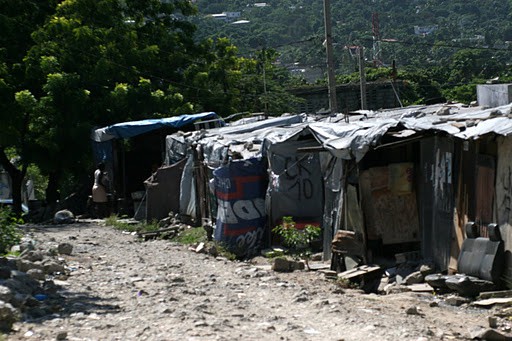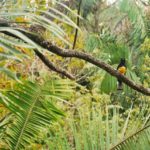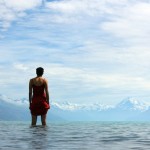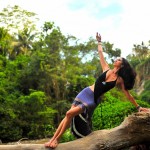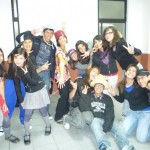Haiti Travel: Heart Breaking Living Conditions
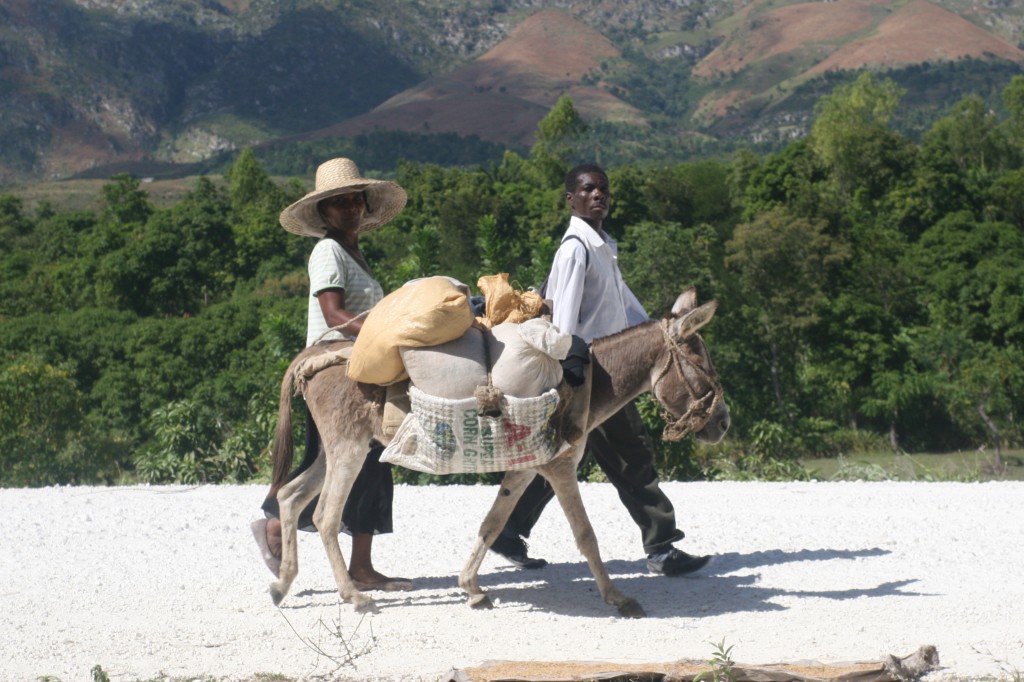
AJWS Development Associate, Stefanie Rubin, recently traveled to Haiti in preparation for the November 2011 AJWS Study Tour to Haiti and the Dominican Republic. Below she shares her reflections and insights about all that she has experienced in just three days.
My mind is still reeling from everything we’ve seen during the past few days in Haiti. Clips of what we’ve experienced and the grantees we’ve visited keep bubbling to the forefront of my consciousness and lap over me in waves of emotion.
Today began with another long car ride, weaving through a mess of buildings toppled over like a child’s set of blocks, against a backdrop of green, spectacularly beautiful mountainsides sloping toward an idyllic Caribbean coast. Woven into the landscape are banners of blue, white and grey calling out to us in familiar code: USAID, UNICEF, PR of CHINA, Rotary International.
Our van slowed to a crawl as we navigated our way through yet another bustling market swarmed with shoppers haggling over everything from bushels of plantains (a staple in Haitian cuisine) to scented lotions and candles, to brightly painted jewelry and hand stamped metal sculptures. Life, even in the face of extreme adversity, goes on.
I had seen the “before and after” photos on the news last year, but seeing it first hand was deeply moving.
As we made our way into the heart of downtown Port au Prince, we caught our first glimpse of the National Palace, which sustained heavy damages after the quake. I had seen the “before and after” photos on the news last year, but seeing it first hand was deeply moving. The visual was not a complete surprise. But what we discovered immediately across the street—“The Champ de Mars Plaza”—will stay with me long after I return home.
“Before the earthquake, this was a beautiful park,” our guide tells us. “School children would have their physical education classes here while ambassadors and businessmen lounged on benches and discussed the news of the day. This plaza is to Haiti as Central Park is to New York or the National Mall is to Washington, DC.” No further explanation is needed; the sight before us said it all. The tarp tents and corrugated metal shacks are housed so close to one another that any evidence of open green fields or paved walkways is gone.
I closed my eyes and tried to imagine Central Park filled with makeshift shelters from end to end, filling the Sheep’s Meadow and Strawberry Field. Then I imagined living in that tent for 19 months. If there are words to describe what that experience must be like, they belong to someone far more eloquent than me.
Haiti Travel: Heart Breaking Living Conditions
Soon we reached our destination, the offices of AJWS’s grantee Groupe d’Appui aux Rapatries et aux Refugies (GARR), a grassroots group working to make the living conditions in the camps more tolerable while fighting against unlawful camp evictions and advocating for fair housing rights. Awaiting us was the very special opportunity to speak with Collette, GARR’s director and a staunch advocate for the rights of displaced persons.
She arranged for us to meet with a group of women and children who are living in the IDP camps and receiving GARR’s services. Collette explained how the focus of the organization has evolved over the years from Haitian-Dominican immigration and migration issues to broader human rights advocacy. For nearly twenty years, GARR has been advocating for the fair and equitable treatment of deportees, migrants, and displaced persons.
After the earthquake, it was the logical step to advocate for the rights of the 1.7 million newly homeless and displaced people.
Anywhere but here seems to be the consensus, but with virtually no assets, no low-income or affordable housing, and few job opportunities, most of these families will end up in worse conditions than they face now.
Access to housing is a huge issue here. The new rap superstar turned President Michel Martelly faces increasing pressure to clear the IDP camps and steamroll evictions. But there has been little discussion of where it’s expected these people will move to.
Anywhere but here seems to be the consensus, but with virtually no assets, no low-income or affordable housing, and few job opportunities, most of these families will end up in worse conditions than they face now. To combat this GARR, along with a coalition of grassroots partners including fellow AJWS grantee Movimiento De Mujeres Dominico Haitiana (MUDHA), is organizing an advocacy campaign in support of legislation to recognize access to safe, affordable housing as a basic human right – not a luxury.
Until this vision becomes a reality, GARR is doing what they can to improve the quality of life for residents of IDP camps and has trained over 200 individuals to monitor the safety, security and social needs of over 50 camps in and around Port au Prince.
They see a need, and are doing what they can to fill it.
A group of children raved about the recently created youth club where activities like painting, singing, jewelry making and sports are coordinated free of charge. One young boy about the age of 8 told us he wasn’t able to go to school for almost a year after the earthquake because his family couldn’t afford the fees.
Now, thanks to GARR, he’s back in class again. The mothers took time to echo their children’s praises.
To hear how full of hope these women and children are is beyond inspirational.
They add that GARR has provided them with access to basic necessities like showers and clean water (a huge concern in light of the expanding cholera outbreak) and vocational activities, the value of which cannot be over emphasized. To hear how full of hope these women and children are is beyond inspirational.
After a delicious lunch of grilled red snapper with Creole style rice, beans and fried plantains we made our way to MUDHA’s office where our partners were preparing for their first graduating class of women entrepreneurs. Signs of the upcoming ceremony and exhibition were everywhere.
In one room, students prepared stacks of molded and painted candles while others feverishly worked to complete their interior design showpieces including bedspreads, pillow cases, towels and kitchen accessories. Before coming to MUDHA as one woman puts it, “we were sitting in the camps doing nothing” with no sense of autonomy and little confidence in their ability to lift themselves out of poverty.
The newly found self-esteem was clearly imprinted on each of their faces as they stood proudly to share their accomplishments. Several young women introduced themselves as leaders of the youth group working to engage their peers in social action and push for the resources they know they deserve – an education, a local library, a clean and safe community.
An emergency phone service has been coordinated so that if a woman witnesses an attack or has been targeted, help is only a speed dial call away.
Other women talked about how valuable MUDHA’s initiative to combat gender-based violence in the IDP camps has been. Over the past year, MUDHA has distributed flashlights and whistles to the female IDP residents and has been diligently working with local law enforcement on sensitivity training so that victims of gender-based violence are not further traumatized by aggressive questioning.
An emergency phone service has been coordinated so that if a woman witnesses an attack or has been targeted, help is only a speed dial call away. Recently, an attempted murder was thwarted thanks to one such phone call. While there is clearly more work to be done, the amazing efforts of our partners have already helped countless women stay clear of harm’s way.
Proper sanitation is another priority issue. Sonia Pierre, MUDHA’s executive director, shared some astounding data with us: Though the cholera epidemic has reached their camps, the survival rate is one of the highest in Haiti thanks to their public health program.
I don’t know what I expected Haiti to be like. But, I know I never imagined it would be anything close to what we’ve experienced over the past three days. The impact of AJWS’s work in Haiti is expansive and incredibly impressive. We’ve seen how partners like BRAC are working to literally piece people’s lives back together by providing amputees and other seriously injured earthquake victims with new limbs and braces.
Even though our journey is only midway through, I already can’t wait to return in November for AJWS’s Study Tour.
Other grantees like Fondacion SEROvie continue to pioneer the fight for LGBTI rights and HIV/AIDS prevention. While the earthquake has clearly impacted the work of our partners and, in some instances, dramatically changed their areas of focus, I am completely awe struck by the beauty and resiliency of spirit we’ve found across the country.
Even though our journey is only midway through, I already can’t wait to return in November for AJWS’s Study Tour.
Haiti Travel: Heart Breaking Living Conditions
Related Reading
Drawing Maps in Haiti: In Conversation with Allison Coffelt
Travel Haiti: A Coversation with Melissa Adler
Music and Medical Missions Trip to Haiti: A Conversation With Aliz Koletas
Have you traveled to Haiti? What where your impressions? Email us at editor@pinkpangea.com for information about sharing your experience and advice with the Pink Pangea community. We can’t wait to hear from you.
Haiti Travel: Heart Breaking Living Conditions l photos are by Ruth W. Messinger. Courtesy of American Jewish World Service.

